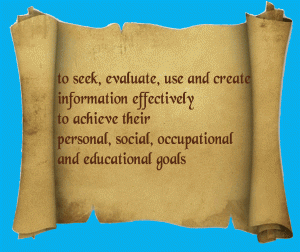Information Literacy is the teacher librarian’s specialist subject, but it is a whole school responsibility.
In the K-12 education sector, information literacy is a double-edged concept. There is the workplace culture that Henri (1995) calls the ‘information literate school community’ (ILSC) and which he describes as “a philosophy as well as a place; it is a way of being as well as a working model. It is a mindset as well as a map,” (Henri, 2005, p11). There is also the pedagogical platform of a skillset based on the definition that to be information literate means “being able to recognize when information is needed and have the ability to locate, evaluate, and use effectively the needed information.” (American Library Association, 1989, para 3).
Many, such as Eisenberg (2009), argue information literacy underpins all other literacies and is the foundation of lifelong learning defined as “the systematic acquisition, renewal, upgrading and completion of knowledge, skills and attitudes made necessary by the constantly changing conditions in which people now live.” (Candy, cited in O’Sullivan, 2002). While the ability to locate, evaluate, interpret, select, organise and use information has always been a skill required of students – indeed, the population generally- it was the development of the Internet that has had the most significant impact. Internet usage is now so widespread that over 34% of the world’s population has access, an increase of more than 566.4% since 2000 (World Internet Usage Statistics, 2012). It is estimated that by 2015, Brazil, Russia, India, China, and Indonesia alone will add 610 million users (Boston Consulting Group, 2010).
While it took 1850 years for all that was known in the time of Jesus Christ to double, in 2002 and prior to Web 2.0 technologies, it was estimated that, spanning the four storage systems of print, film, magnetic and optical and the information conduits of telephone, television, radio, and the Internet, five exabytes (1018) of information) were produced that year – about 800MB per person on the planet. (Lyman & Varian, 2003). In addition, researchers suggest that, in 2008, Americans alone consumed “information for about 1.3 trillion hours, an average of almost 12 hours per day. Consumption totalled 3.6 zettabytes [1021] and 10,845 trillion words, corresponding to 100,500 words and 34 gigabytes for an average person on an average day.” (Global Information Industry Center, 2009).
From this burgeoning, incessant production has arisen a new paradigm – information literacy, a term first coined by Zurkowski (1974) who used it to refer to workers who had mastered using information tools as well as their primary materials to solve work-based issues and which, by 2005, was identified as “a basic human right in the digital world” enabling individuals “in all walks of life to seek, evaluate, use and create information effectively to achieve their personal, social, occupational and educational goals” by the Alexandria Proclamation.
The Adelaide Declaration on National Goals for Schooling in the 21st Century acknowledged this right when it stated,
Australia’s future depends upon each citizen having the necessary knowledge, understanding, skills and values for a productive and rewarding life in an educated, just and open society … when students leave schools they should have the capacity for, and skills in analysis and problem solving and the ability to communicate ideas and information, to plan and organise activities and to collaborate with others.
Students will need to be able to survive and thrive in an information-saturated and technology-rich environment, and be independent, creative thinkers, making informed decisions based on careful evaluation and interpretation of available information, developing expertise through experience, and be lifelong learners. They need to be information literate. And as the ability to be able to access whatever, whenever, wherever becomes the norm, we, as teacher librarians, need to change our thinking so that rather than being the source or the gatekeepers of the information (as we were in a print-dominated society) we need to see ourselves as the filter. While the front end of the information literacy process involving location, selection and organisation remains important, it is the back end such as validation, synthesis, leverage, communication, collaboration and problem-solving with information that are the critical elements of information literacy in the 21st century. The what and the why are summarised in this clip which was created as a summary of the ASB Unplugged Conference in Mumbai, India 2010. It compiles thoughts from leaders in technology education and explores the big topics of conversation around what the 21st century classroom looks like. It demonstrates that these skills need to be an across-curriculum perspective, spear-headed by the teacher librarian but not limited by artificial boundaries such as physical location, job description and so forth.
Therefore, even though information literacy is the specialist subject of the teacher librarian, the creation of an information literate school community cannot rest on one pair of shoulders.
An ILSC is one that “places a high priority (policy, benchmarking, funding and evaluation) on the pursuit of teacher and student mastery of the processes of being informed,” (Henri, 2005, p12). The community (which comprises all stakeholders including the principal, the teacher librarian, teachers and ancillary staff, students and parents) is built on collaboration, constructivism and constructionism with each member having a clear focus and responsibility so the synergy of the parts ensures the success of the whole.
Rather than being an individual experience, learning becomes a collaborative and co-operative interaction dependent on its particular context to give it value and determine its application and communication. Learners are “engaged, enabled, enriched and embodied by social, procedural and physical information” (Lloyd, 2010, p30). A successful ILSC is driven by the staff led by the principal and teacher librarian, who, as the information specialist in the school, can enable classroom-based teachers to shape their teaching so it sits on a solid information literacy platform. It requires a sustained commitment by willing partners who are prepared to evaluate, initiate and change philosophies, policies, programs, practices and priorities and invest time, money and effort in achieving the goal.
However, despite the demonstrated need for information literacy beyond the formal education period, and the evidence from numerous studies (summarised in Kachel, 2011) that “quality school library programs impact student achievement” (Kachel, 2011, p4) information literacy is still seen by many practitioners as “library skills” focusing on and confined to students’ use of print materials in the library and taught while they have their preparation and planning time. There is no broader vision that values and validates information literacy as an across-curriculum perspective with purpose and application in all spheres of life.
Thus, it becomes the TL’s job to drive the change towards an ILSC.
But if change is to be successful, it will have to explicitly demonstrate that it will improve quantitative student outcomes, rather than just making a more meaningful learning experience, as regular external testing is now used to measure a school’s ‘success’. It will require a clear blueprint that demonstrates the transition to an ILSC is not just a fad that will add to teachers’ workload. Critical elements of that blueprint are
- The principal’s support is imperative for success and there must be an expectation that the TL will take a leadership role and that staff will be required to make the requisite changes
- Staff will need to understand the concept of and the need for an ILSC, and be actively involved in the changes to policies, programs, practices and priorities enabling them to invest in and take ownership of the new philosophy
- If learning is to be successful it must engage students by meeting their needs and interests based on a constructivist, problem-solving approach
- The depth and breadth of the TL’s role in the 21st century needs to be clear and accepted and thus the TL must be part of a collaborative team involved in planning, preparation and assessment practices so that information skills are taught in context not isolation.
- The library, its programs and its collection need to be viewed as the hub of the teaching and learning in the school community.
- Parents need to be informed of and active participants in changes of philosophy, pedagogy and practice.
- The transition to an ILSC will need to be gradual as such significant change needs to be planned and supported so concepts become culture as community members embrace and take ownership of a new era in education for the students at this school.
Thus there needs to be a plan in place and for that the TL will have to put on the planner’s hat.
Links
Information skills in the school: engaging learners in constructing knowledge (NSW Department of Education)
School Libraries & Information Literacy (NSW Department of Education)
Beacons of the Information Society: The Alexandria Proclamation on Information Literacy and Lifelong Learning, 2005
Information Literacy: the most basic of basics (Mike Eisenberg)
Information Literacy models (a summary of some of the models as well as a graphic)
ILSC rubric Adapted from Henri, J., Hay, L. and Oberg, D. (2002). The School Library-Principal Relationship: Guidelines for Research and Practice. [International Federation of Library Associations and Institutions (IFLA) Professional Report]. The Hague, Netherlands: IFLA Headquarters, p.90.
Kathy Schrock’s Guide to Everything
Unlinked References
Henri, J. (1995). The information literate school community: exploring a fuzzy concept. Scan (14)3: 25-28
Henri, J. (2005). Understanding the information literate school community. In J. Henri & M. Asselin. (Eds.). The information literate school community 2: Issues of leadership. (pp. 11-26) Wagga Wagga, NSW, Australia: Centre for Information Studies
Lloyd, A. (2010) Learning from the workplace: Theorizing an architecture for understanding information literacy as practice. In Lloyd, A & Talja, S (Eds.) Practising information literacy: Bringing together theories and information literacy practice (p29-49) Wagga Wagga, NSW Australia: Centre for Information Studies, Charles Sturt University
O’Sullivan, C. (2002). Is information literacy relevant for the real world. Reference Services Review, 30(1): 7-14.
Zurkowski, P. (1974). The information service environment: Relationships and Priorities. National Commission on Libraries and Information Science, Washington DC, ERIC Clearinghouse on Information Resources, ED 100391.

